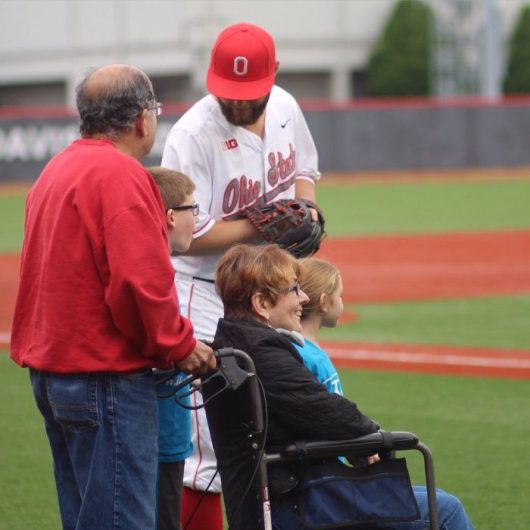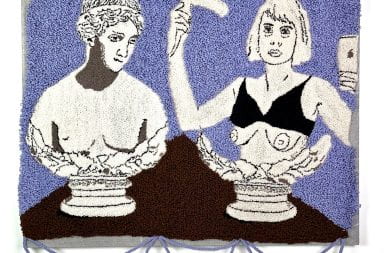
Jake Brobst (14) greets the Martinez family on May 3, ALS Awareness night at Bill Davis Stadium. Courtesy: OSU Athletics
“I might have been given a bad break, but I’ve got an awful lot to live for.” That was former New York Yankees great, Lou Gehrig, on July 4, 1939, announcing his retirement from baseball in front of a capacity crowd at Yankee Stadium. No one knew the severity of Gehrig’s disease at the time, not even the Hall of Famer.
The game of baseball has adopted ALS awareness because of the impact it had on one of the game’s patriarchs. Baseball’s connection with ALS even has roots within Ohio State. Steve Brobst, father of OSU baseball senior outfielder Jake Brobst, has helped to lead the charge against ALS locally.
Nearly 80 years since Gehrig’s speech brought the condition to the national stage, ALS is commonly referred to as “Lou Gehrig’s disease” and is considered to be one of the most debilitating diseases in the world. ALS is a terminal disease which has a prognosis of two to five years.
The disease is characterized as a motor-neuron disease based on the degeneration and death of motor neurons in people with ALS, according to the National Institute of Neurological Disorders and Strokes. It causes voluntary muscles to stop working, which impedes motor function and, eventually, one’s ability to walk, eat, talk and read.
The month of May is designated as ALS awareness month, which is when the campaign to find a cure for the disease jumps into full swing. Marlin Seymour is the executive director of the Central and Southern Ohio ALS chapter, which oversees 55 counties, including the Columbus area. Her chapter provides services free of charge, such as nurses and social workers on staff, running local support groups for families of patients of the disease and loaning out medical equipment to families in need of aid.
“We like to have the opportunity to go out on the field and have a public service announcement and really kind of get the word out to a group of people who typically wouldn’t hear about ALS,” Seymour said.
Almost seven years ago, Seymour met Steve Brobst at an OhioHealth clinic when he stopped by to pick up a “Strike Out ALS” bracelet. From that point on, he has been instrumental in developing a partnership between Seymour’s ALS chapter and OhioHealth, which he was affiliated with at the time. Brobst, now, is an athletic trainer at Mt. Carmel hospital.
ALS hits home for both Seymour and Brobst. The former’s mother passed away nearly 20 years ago from ALS, and the latter had a family friend from Alabama who also lost the fight to the deadly disease.
A multidisciplinary clinic at the OhioHealth Westerville, Ohio, location was one of the first constructs established in the relationship between Seymour and Brobst. Seymour said the clinic started with five to 10 patients and has evolved into 50-plus regular clients. Doctors of all fashions rotate around to them, eliminating the hassle of scheduling appointments and the stress for the families dealing with ALS.
Seymour bragged that Brobst was of chief importance in getting members of Congress to sign advocacy letters for ALS research.
“I just did what Marlin told me to do,” he said modestly. “It obviously makes you feel good to do something for someone else less fortunate. To me, obviously it’s always about the patient, but it’s also about the family because it puts so much less stress on the family and their caregivers to be able to pull up and stop and have everything being taken care of.”
With his career as an athletic trainer, Brobst knows the effect illness and injury can have on patients and families. However, he recalled one ALS patient whose story particularly touched him.
The two and another contingent from the ALS chapter went to the Henry Ford Clinic outside of Detroit where Brobst encountered a gentleman who was three or four years younger than he was and had three young kids. The man had been diagnosed with ALS less than two month before then.
“It just sort of hit you like, ‘Oh my gosh,’” Brobst said softly with tears in his eyes. “Here I am stressed out about making it to my son’s baseball game on time or stressed over our kids getting their homework done, and here’s a gentleman who was probably 40 or 41 at the time, and he had just been diagnosed with it with three young kids.”
Brobst said that is one incident he will not soon forget.
Jake Brobst, too, has an emotional pull to ALS. One of his good friends from nearby Bishop Watterson High School, Camey Rabold, senior swimmer at OSU, lost her father to ALS. The senior outfielder said that when he decided to come to OSU and play for coach Greg Beals, he knew that he wanted to bring ALS awareness onto the baseball scene. His dad was a large aspect of his decision.
With the help from Steve and Jake Brobst, Seymour was able to bring the fight against ALS to the OSU community for the third straight year. On May 3, Seymour’s ALS chapter was at OSU’s Bill Davis Stadium for the annual ALS awareness night game against the University of Alabama-Birmingham.
“He’s a servant. He is really willing to go out of his way to help people,” Jake Brobst said regarding his father’s work with the ALS Association. “Being able to serve that group of people is really just a huge testament to his character, his heart for people.”
“It’s just one of those things that you find a cause and that you believe in, and this is something I felt compelled to and want to help with,” Steve Brobst said.
The family of Thelma Martinez, an ALS patient of two-and-a-half years in Seymour’s chapter, was given the honor of throwing out the ceremonial first pitch. Martinez watched her grandson, Mario, bounce the pitch into the mitt of Jake Brobst. Martinez, sitting in her handicap chair, was accompanied by her husband Henry and their daughter, Melissa Bondy, and granddaughter.
“It was cool to catch the first pitch,” said Jake Brobst, the Buckeye outfielder. “It seems like something small but it was a big deal to Mario and to his family.”
Martinez is among the 25 percent of ALS patients who have bulbar onset, which impacts the voice of the patient first. Communication with his wife, Thelma, proves to be difficult at times for Henry Martinez.
“What was the first one?” Henry Martinez said trying to understand Thelma’s sign language. “N, O, S, R… sorry. S, U…”
“Survivors. There aren’t a lot of survivors,” interjected Bondy. It took all of 30 seconds to realize the perplexing situation ALS has donned on the Martinez family.
“I wasn’t prepared to lose the ability to have a conversation, and that was surprising to me,” Bondy said about her mother’s condition. “Watching her lose her independence … it’s tough on her, it’s tough on us. It’s all consuming. It’s our lives now.”
Henry Martinez echoed Bondy, saying that their lives are changed forever because of this disease.
But on that night, the Martinez family enjoyed a ball game at Bill Davis Stadium knowing that for the moment, things were peaceful.
Jake Brobst is in the midst of playing his final games as a Buckeye at the Big Ten tournament in Omaha, Nebraska. The Buckeyes are 13-2 in their last 15 games, including Wednesday night’s victory over Michigan when the outfielder was heroically clutching the team’s iconic scarlet- and gray-painted battle axe, which has been in the clubhouse over the 15-game stretch.
Sitting with his family, Steve Brobst is savoring the final chapter of the game he and his son have shared for over 15 years. Some things are larger than sports. ALS and the connection between father and son are two of those.
As much as Jake Brobst has enjoyed the recent success of his team, his father has enjoyed the prosperous string of games equally. When he’s not volunteering with Seymour and other ALS associates, Steve Brobst seems at home, at peace in the seats of a ballpark volunteering his time for perhaps the most significant chunk of his life: baseball and his son.


